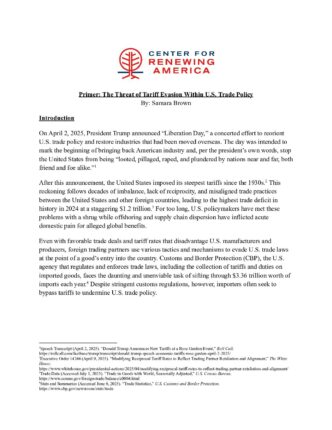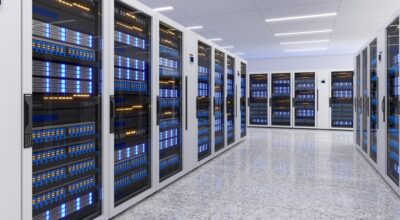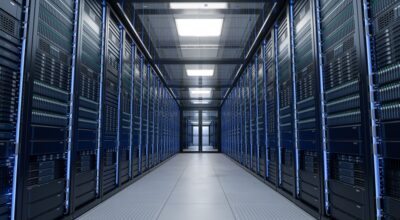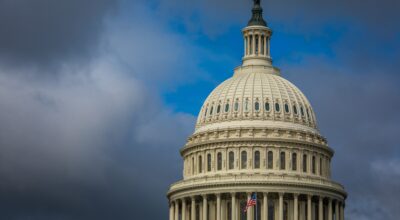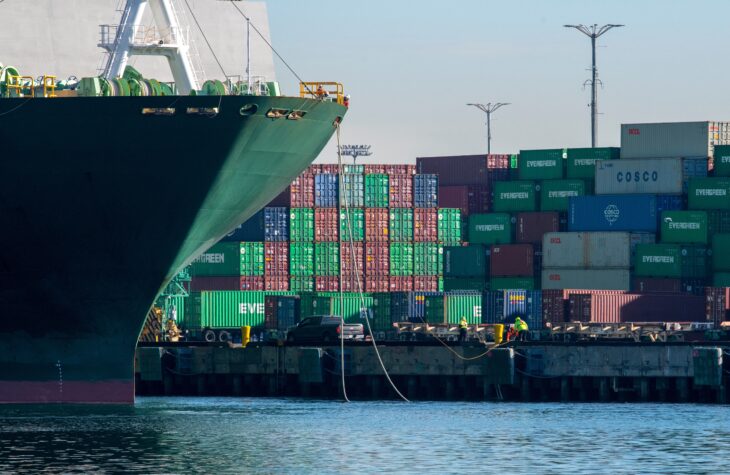
Primer: The Threat of Tariff Evasion within U.S. Trade Policy
Introduction
On April 2, 2025, President Trump announced “Liberation Day,” a concerted effort to reorient U.S. trade policy and restore industries that had been moved overseas. The day was intended to mark the beginning of bringing back American industry and, per the president’s own words, stop the United States from being “looted, pillaged, raped, and plundered by nations near and far, both friend and foe alike.”1
After this announcement, the United States imposed its steepest tariffs since the 1930s.2 This reckoning follows decades of imbalance, lack of reciprocity, and misaligned trade practices between the United States and other foreign countries, leading to the highest trade deficit in history in 2024 at a staggering $1.2 trillion.3 For too long, U.S. policymakers have met these problems with a shrug while offshoring and supply chain dispersion have inflicted acute domestic pain for alleged global benefits.
Even with favorable trade deals and tariff rates that disadvantage U.S. manufacturers and producers, foreign trading partners use various tactics and mechanisms to evade U.S. trade laws at the point of a good’s entry into the country. Customs and Border Protection (CBP), the U.S. agency that regulates and enforces trade laws, including the collection of tariffs and duties on imported goods, faces the daunting and unenviable task of sifting through $3.36 trillion worth of imports each year.4 Despite stringent customs regulations, however, importers often seek to bypass tariffs to undermine U.S. trade policy.
Background: How Goods Get into the United States
Before highlighting concerns over the impact of tariff evasion, it is important to outline the baseline procedures for importing goods into the United States from foreign countries. The importation process begins when goods arrive at U.S. ports, airports, or border crossings. The process can be broken down into several key steps:
- Arrival Notification: Upon arrival, the shipping carrier notifies CBP of the incoming goods. This is typically done through an electronic submission called an “entry manifest” or an “arrival notice.”
- Cargo Documentation: Importers or their representatives at ports of entry are required to submit specific documents, including:
- Bill of lading: This document details the shipment’s contents and serves as a receipt and proof of ownership.
- Commercial invoice: This document indicates the value, payment terms, and origin of goods.
- Packing lists, additional certificates of origin, and other documentation based on the product type.
- Customs Entry: To clear goods through U.S. Customs, importers must file an Entry Summary, which provides further details on the classification, origin, and value of the goods being imported. This information is how CBP determines the correct duties, tariffs, and taxes for each good.
- Inspection and Examination: CBP conducts risk-based assessments of goods. This includes selecting shipments for inspection based on factors such as compliance history, country of origin, and product type. Goods may also be subject to a physical examination or may be assessed through data analysis, including container scanning.
- Release of Goods: Once CBP reviews the required documentation and ensures compliance, the goods are cleared for entry and may be released to the importer.
The classification of imports is critical for determining which duties, tariffs, and taxes should be applied. When assessing imports, CBP has a process to ascertain the correct tariff(s) to apply to imported goods. The primary factors included in this assessment are:
- Harmonized Tariff Schedule (HTSUS): The United States follows the Harmonized System (HS), an international nomenclature for classifying goods. The HTSUS classifies imported goods based on their description, function, and material composition. Each classification has a specific duty rate attached.
- Valuation of Goods: U.S. law mandates that goods be valued based on the transaction value, which is the price paid or payable for the goods when sold for export to the United States, adjusted for factors like shipping, insurance, and other costs.
- Country of Origin and Existing Trade Agreements: The country of origin affects tariff rates. For example, goods from countries that have trade agreements with the United States (e.g., Canada and Mexico) may qualify for preferential tariff treatment. Conversely, goods from countries facing trade sanctions or high tariffs (e.g., reciprocal tariffs on China) may be subject to additional tariffs.
- Antidumping and Countervailing Duties: U.S. law also imposes antidumping duties on goods sold below their fair market value and countervailing duties on subsidized goods. These duties are assessed when CBP determines that foreign exporters are engaging in unfair trade practices that harm U.S. producers.
Analysis: Tariff Evasion Tactics and Their Impacts
The Biden border crisis inflicted severe damage on the United States. During the four years of the Biden administration, Americans experienced record illegal immigrant apprehensions and border crossings, skyrocketing human trafficking operations, prolific cartel-directed drug smuggling, and sobering numbers of fentanyl-related overdose deaths. The infusion of more than twelve million illegal immigrants into the United States stretched an already overwhelmed CBP beyond its capabilities,5 transforming the agency into a migrant greeting operation through the catastrophic CBP One app and the Biden administration’s catch-and-release directives. A potential consequence of this invasion is the deleterious impact it had on CBP’s import control operations.
Nearly one-third of CBP’s budget is dedicated to its Trade Operations division.6 Even with the greater operational emphasis on the agency’s border control operations, policymakers have argued for years that the agency is undermanned in its mission to secure the border. This is likely true for its customs and import control operations as well. The drawn-out nature of customs fraud obfuscates the extent of the problem in many ways, as investigations into a single entity average eighteen months, and successful cases can take two and a half to three years to bring to a conclusion.7
Unsurprisingly, foreign entities and import-export businesses employ various tactics and methods to circumvent U.S. trade remedy laws by exploiting loopholes and taking advantage of the slow pace of investigations. These efforts typically come in one of four forms:
- 1. Misclassification: Exporters seeking to circumvent U.S. trade provisions sometimes use incorrect HS codes to avoid tariffs and duties. A 2017 Government Accountability Office report found that importers often misclassify goods, and CBP does not detect or catch all of these misclassifications.8
- 2. Origin Fraud and Transshipment: One of the most common methods of circumvention involves transshipment, where goods are shipped through third-party countries to avoid tariffs and duties.9 The goods may originate in a country subject to antidumping or countervailing duties but are rerouted through another country that is not facing such duties, thereby evading tariffs. Foreign exporters may also forge certificates of origin to misrepresent the true country of origin, allowing the goods to qualify for lower tariffs or even tariff exemptions under free trade agreements.
- 3. Undervaluation or Misreporting of Goods: Some foreign entities may attempt to underreport or misreport the prices of their goods to reduce the calculated dumping margins. This is typically achieved through incorrect declarations on invoices or shipping documents, or through falsification of financial records.
- 4. Processing Alterations: Some entities employ less obvious tactics. One of these involves making minor modifications to products in third countries to make them appear as though they are of local origin, thus circumventing antidumping or countervailing duties.
The extent to which entities engage in such practices is not fully known; however, there is significant evidence that foreign entities, particularly those with domestic distributors, understand how to exploit the system and circumvent existing U.S. trade laws. An example can be found in some of the latest trade data with China.10
With the imposition of steeper tariffs on China, the country’s exports to the United States dropped a steep 34.6 percent from May 2024 compared to May 2025. Yet, other countries had significant increases in their exports to the United States during the same period. According to Chinese government data, China exported 28.2 MT more to Vietnam, Thailand, Malaysia, Philippines, India, and Mexico in May 2025 than they did in May 2024.11 Those same nations exported 26.4 MT more to the United States in May 2025 than they did in May 2024.
This data strongly suggests the transshipment of goods that are circumventing the impact of U.S. tariffs.
Domestic import businesses have also been targeted for attempting to evade tariffs. Last year, a Miami tire business owner pled guilty to country of origin fraud by intentionally providing false invoices to CBP concerning the origin of his imported truck tires.12 The tires were made in China, but the man circumvented higher tariffs by asserting in various cases that the country of origin was Malaysia, Canada, and other nations with lower tariff rates. In 2023, a Florida couple pleaded guilty to a tariff evasion scheme involving the false reporting of the country of origin, country of harvest, and species of imported plywood. This sophisticated scheme involved relocating plywood from China (its actual point of origin) to Malaysia or Sri Lanka, where the wood was transferred from its Chinese containers into different containers to conceal its origin. The couple was sentenced to five years in prison.13
Other recent tariff evasion examples include a New York–based vitamin importer that misclassified products to circumvent tariffs, a Texas-based furniture importer that worked with Chinese manufacturers to falsify invoices, and a German industrial-engineering company that paid a $22.2 million settlement to the U.S. government for undervalued and misclassified stainless steel pipe products.14
While their strategies are arguably less egregious than those of entities that employ major tariff evasion tactics, both Converse and Columbia Sportswear have been reported to reengineer products to achieve lower tariff rates. Converse places a layer of felt on the bottom of its All-Star sneakers so they can be classified as “slippers” for a 6 percent duty instead of a 20 percent duty for athletic shoes.15 Similarly, Columbia places pockets below the waistline of its women’s blouses to avoid the 26.9 percent duty on such products and pay a rate of 16 percent instead for clothing classified differently under the HS code due to pockets near the waistline that tighten the garment.16
Last year, Ford paid a $365 million settlement to the U.S. government after it was sued for misclassifying its Ford Transit Connect (a small passenger vehicle used for various service tasks) from 2009 to 2013 to pay a 2.5 percent car tariff instead of the 25 percent truck tariff.17
A recent and ongoing case involves a global chemical supply company based in China, which distributes its products to the United States. The company uses a distribution warehouse headquartered in the northeast to serve its U.S.-based customers. (As this case is still under investigation, the name of the company will be intentionally withheld pending the potential discovery of exculpatory evidence and the outcome of the case.) Nevertheless, the company’s 2024 import data shows 6,476 metric tons of polyether polyols brought into the United States last year. A closer analysis of the company’s import data from the Port of Houston reveals potentially suspicious activities concerning HS code classifications, with a total of 760 metric tons of polyether polyols imported from September 2024 to November 2024. Yet, the import data shows that only 555 metric tons of polyethers (using the correct HS code, 3907.29.000, for polyether polyols) went through the port during that time frame.
This discrepancy amounts to 205 metric tons for a single company within a three-month snapshot at a specific port. Such a discrepancy strongly suggests that the company is misclassifying its polyether polyols to avoid a 35 percent Section 301 tariff and a 3 percent import duty and to continue purchasing products from China.
Additional evidence against this company dates back even further. In late spring 2022, the company imported silicone polymers from India and used the correct HS code (3910.00.000). During that time frame, however, there was no production of silicone polymers of the specified grade occurring in India. When these polymers arrived in Miami, the valuation was $0.38 per kilogram, which is curious given that the price is lower than the feedstocks used to produce such material. During the same time frame, the valuation for such polymers in China ranged from $4.48 to $5.11 per kilogram.
These data suggest that barring exculpatory evidence, both origin fraud and undervaluation of imports are at play. They also indicate the underlying ease with which entities can skirt tariffs, especially when CBP resources are taxed, and investigations are often slow.
Policy Remedies for Tariff Evasion
Following the Liberation Day announcement, some high-profile law firms published primers advising prospective clients in the import-export business to avoid following tariff advice from China-based suppliers lest they risk fines or imprisonment.18 This guidance stems from the numerous laws that have been enacted to protect domestic industries and producers against unfair trade practices.19 These laws are enforced by the U.S. Department of Commerce and the U.S. International Trade Commission (ITC) to level the playing field for American businesses and workers. The Department of Justice then pursues prosecutions over tariff evasion schemes.
Broadly, U.S. trade remedy laws comprise three primary tools to address unfair trade practices: antidumping laws, countervailing duty laws, and safeguard laws (Section 201). Each tool addresses a specific form of unfair trade or harm caused by imports. The laws are designed to protect U.S. industries and workers from unfair competition caused by imports that are priced below fair market value or are subsidized by foreign governments.
- Antidumping Laws: Antidumping laws are intended to address the practice of foreign manufacturers selling goods in the U.S. market at less than fair value, often referred to as “dumping.” Under these laws, if it is determined that dumping is occurring and is causing material injury to a U.S. industry, the U.S. government can impose antidumping duties to offset the unfair pricing.
- Countervailing Duty Laws: Countervailing duties are applied when foreign governments provide subsidies to their domestic industries, allowing them to sell goods at artificially low prices in the U.S. market. These subsidies can take many forms, including direct financial assistance, tax exemptions, and preferential financing terms.
- Safeguard (Section 201) Laws: Section 201 of the Trade Act of 1974 authorizes the U.S. government to impose safeguard measures when a sudden surge of imports threatens to cause serious injury to a U.S. industry. Unlike antidumping and countervailing duty laws, safeguard measures are not based on unfair trade practices but rather on import surges.
These measures provide the federal government with useful tools for protecting American businesses in the macroeconomic sense. However, the acute issue of tariff evasion mostly presents a case-by-case challenge that is far more resource-intensive.
As the border invasion comes to an end and deportation efforts increase, there is an opportunity to reassess the current operational capabilities of CBP when it comes to import control. If policymakers wish to maximize the impact of tariffs to ensure greater protection for U.S. manufacturers, mitigate unfair trade practices, and accelerate reshoring efforts, then it may be necessary to enhance both resources and capabilities within CBP’s Trade Office for import inspection and investigation. A good area for reform is the trade crime reporting process.
CBP utilizes an e-Allegation system as an online resource for reporting suspected trade crimes. Public statistics show a significant gap between reported violations and enforcement outcomes.20 Just for tariff evasion violations, CBP data show that over 2,000 e-allegations were filed in 2023, a significant increase from just a few years prior.21
Yet only a small fraction of these tips resulted in successful enforcement. An audit of FY2019–2020 found that out of 934 duty-evasion allegations submitted, CBP confirmed it took action on only 68 cases (just 7.3 percent), while roughly 75 percent of allegations resulted in no action.22 The remainder were either unconfirmed or referred out, indicating that many reported tariff evasion schemes are not ultimately pursued.
This low hit rate suggests that limited agency resources and procedural hurdles hinder CBP’s ability to respond to the rising tide of tariff evasion reports. It also illustrates that, as the agency can begin to breathe with the border crisis abating, more attention may be directed to peeling back the proverbial onion of the tariff evasion ecosystem.
While it remains to be seen when the opportunity for a strategic reassessment of CBP’s mission may present itself, there is an undeniable need for more inspections, more investigations, and harsher penalties for those who engage in tariff evasion schemes to undermine American businesses and competitors.
Conclusion
With the imposition of broad-based and increased tariffs, policymakers must grapple with the fact that opportunities for tariff evasion have also increased. It is imperative to understand how entities often attempt to avoid increased tariffs and to calibrate accordingly to ensure that such fraud is mitigated. As part of the larger effort to protect domestic manufacturing capabilities and ensure American businesses operate on a level playing field, consideration should be given to increasing the resources and capabilities of federal agencies to accelerate inspections and investigations of potential tariff evasion schemes.
The proliferation of tariff evasion practices also presents China with an opportunity to exploit these methods on a large scale. Beijing could establish import companies within the United States to evade tariffs and then cycle through shell operations as investigations are launched into individual entities. Chinese nationals affiliated with the regime could then leave the country as investigations are closing in to avoid prosecution with a process that rinses and repeats. This possibility poses a significant threat to the United States’ ability to effectively leverage tariff policies to protect domestic industries from unfair and abusive trade practices.
Success in the mission to protect American industry and reshore jobs ultimately relies on ensuring that tariff evasion becomes such a risky proposition that no entity would willingly risk its business or freedom to engage in these fraudulent practices.
Endnotes
1. Speech Transcript (April 2, 2025). “Donald Trump Announces New Tariffs at a Rose Garden Event,” Roll Call. https://rollcall.com/factbase/trump/transcript/donald-trump-speech-economic-tariffs-rose-garden-april-2-2025/
2. Executive Order 14266 (April 9, 2025). “Modifying Reciprocal Tariff Rates to Reflect Trading Partner Retaliation and Alignment,” The White House. https://www.whitehouse.gov/presidential-actions/2025/04/modifying-reciprocal-tariff-rates-to-reflect-trading-partner-retaliation-and-alignment/
3. Trade Data (Accessed July 1, 2025). “Trade in Goods with World, Seasonally Adjusted,” U.S. Census Bureau. https://www.census.gov/foreign-trade/balance/c0004.html
4. Stats and Summaries (Accessed June 6, 2025). “Trade Statistics,” U.S. Customs and Border Protection. https://www.cbp.gov/newsroom/stats/trade
5. Press Release (August 20, 2024). “GOP Releases Report on Border Crisis,” House Republican Conference. https://www.gop.gov/news/documentsingle.aspx?DocumentID=1840
6. U.S. Customs and Border Protection Budget Overview (2024). “Fiscal Year 2025 Congressional Justification,” Department of Homeland Security. https://www.dhs.gov/sites/default/files/2024-04/2024_0314_us_customs_and_border_protection.pdf
7. Tycko, J. (June 21, 2024). “Customs Fraud Whistleblowing: Combat Evasion & Earn Rewards,” The National Law Review. https://natlawreview.com/article/customs-fraud-whistleblowing-combat-evasion-earn-rewards
8. Government Accountability Office Report (June 2017). “Improved Planning Needed to Strengthen Trade Enforcement,” Government Accountability Office. https://www.gao.gov/assets/gao-17-618.pdf
9. Press Release (January 6, 2025). “The Not-So-Secret Way to Bypass U.S. Tariffs,” Across the Ocean Shipping. https://us.atoshipping.com/the-not-so-secret-way-to-bypass-u-s-tariffs/
10. Trade Data (accessed July 1, 2025). “Trade in Goods with China, May 2024 and May 2025,” U.S. Census Bureau. https://www.census.gov/foreign-trade/balance/c5700.html
11. General Administration of Customs of the People’s Republic of China (accessed July 1, 2025), “China’s Regional Exports, May 2025 vs. May 2024” (data release). http://english.customs.gov.cn/statics/report/month
12. Press Release (December 6, 2024). “Miami Importer Pleads Guilty to Scheme to Evade U.S. Tariffs on Chinese-Made Truck Tires,” United States Attorney’s Office, Southern District of Florida. https://www.justice.gov/usao-sdfl/pr/miami-importer-pleads-guilty-scheme-evade-us-tariffs-chinese-made-truck-tires
13. Press Release (October 19, 2023). “Florida Couple Pleads Guilty to Scheme to Evade $42 Million in Duties for Illegally Importing and Selling Plywood,” Department of Justice. https://www.justice.gov/archives/opa/pr/florida-couple-pleads-guilty-scheme-evade-42-million-duties-illegally-importing-and-selling
14. Investigations and Enforcement Watch (April 7, 2025). “Tariffs Are Here—Be Aware of Criminal and Civil Enforcement Risks,” Cooley. https://investigations.cooley.com/2025/04/07/tariffs-are-here-be-aware-of-criminal-and-civil-enforcement-risks/
15. Treisman, R. (March 7, 2025). “A Look at Some of the Creative Ways Companies Try to Dodge High Tariffs,” NPR. https://www.npr.org/2025/03/07/nx-s1-5318785/tariff-dodging-companies-exemptions-engineering
16. Ibid.
17. Press Release (March 11, 2024). “Ford Motor Company Agrees to Pay $365M to Settle Customs Civil Penalty Claims Relating to MIsclassified and Under-Valued Vehicles,” Department of Justice. https://www.justice.gov/archives/opa/pr/ford-motor-company-agrees-pay-365m-settle-customs-civil-penalty-claims-relating
18. Harris, D. and Lee, A. (May 7, 2025). “Why Following Your Chinese Supplier’s Tariff Advice Could Land You in Jail,” Harris Sliwoski. https://harris-sliwoski.com/chinalawblog/why-following-your-chinese-suppliers-tariff-advice-could-land-you-in-jail/
19. Casey, C. (October 3, 2024). “Trade Remedies: Antidumping and Countervailing Duties,” Congressional Research Service. https://www.congress.gov/crs-product/IF10018
20. e-Allegation Program (accessed July 1, 2025), “Filing A Trade Violation Allegation,” U.S. Customs and Border Protection. https://www.cbp.gov/trade/e-allegations
21. Trade Violations Reporting Tool (access July 1, 2025). “e‑Allegations Statistics by Calendar Year,” U.S. Customs and Border Protection. https://www.cbp.gov/trade/e-allegations/statistics
22. OIG Report (March 2024). “CBP Needs to Enhance its Monitoring and Tracking of the Outcomes of Investigations into the Underpayment of Duties” U.S. Treasury Office of Inspector General, https://www.oig.treasury.gov/system/files/2024-03/(OIG-24-026)_CBP_Investigations_Into_Underpayments_of_Duties.pdf.


